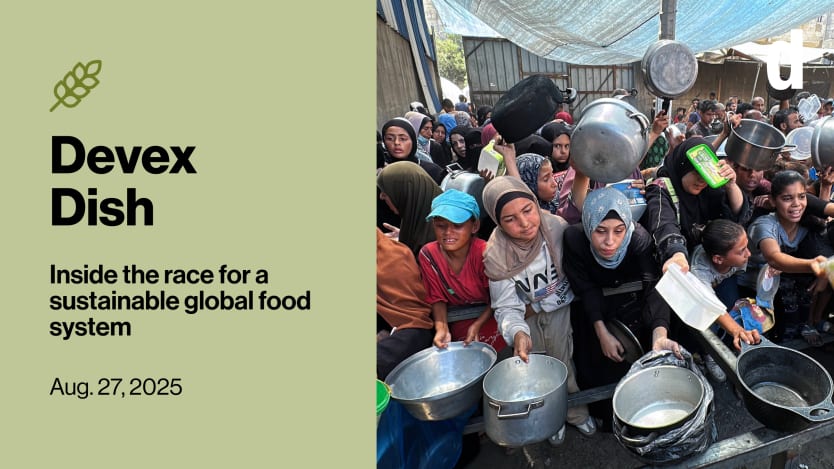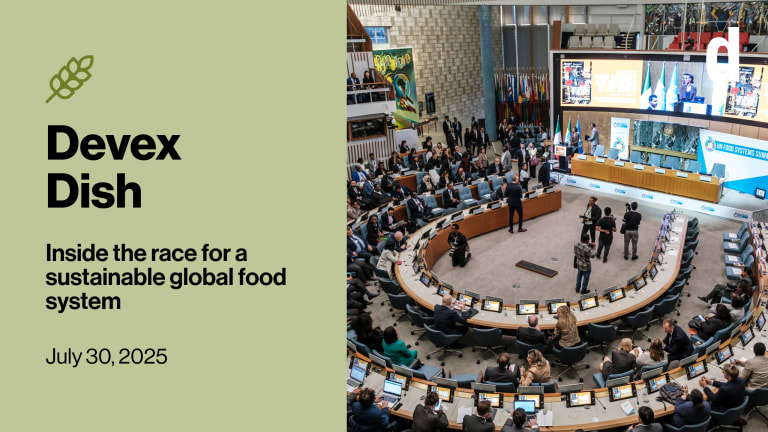
Famine was officially confirmed in Gaza on Friday, marking the first time since the start of the conflict that a United Nations-backed food security monitoring group concluded that all three thresholds that define a famine have been crossed.
The report from the Integrated Food Security Phase Classification, or IPC, is sobering in its details: A famine it calls “entirely man-made” has taken hold in Gaza City and is rapidly spreading elsewhere, with “half a million people facing catastrophic conditions characterised by starvation, destitution and death.” Children, who are particularly vulnerable to malnutrition, are already dying. “The time for debate and hesitation has passed,” it states. “There should be no doubt in anyone’s mind that an immediate, at-scale response is needed.”
The report is also sobering in light of another famine taking place in Sudan, where last year IPC’s Famine Review Committee detected famine in at least five conflict-affected areas. The numbers were staggering: Around 25 million people in Sudan were experiencing high levels of acute food insecurity, or Phase 3 on IPC’s scale, and 638,000 were already at famine levels, known as Phase 5: “catastrophe.” Today, those figures have hardly improved.
IPC has classified five food crises as famines since it was established in 2004, with the first being Somalia in 2011. Gaza marks the first time in IPC’s history that two famines are ongoing simultaneously. Michael Fakhri, the U.N. special rapporteur on the right to food, points out that Sudan is the largest famine in modern history, while Gaza is the fastest. “And in both cases it was predictable and therefore preventable,” he tells me. Back in January 2024, Fakhri had told me famine was “inevitable” in Gaza given Israel’s blockade of humanitarian aid and destruction of farmlands, severely hindering people’s ability to either obtain food or grow it themselves.
The Nobel Prize-winning development economist Amartya Sen famously asserted that famines cannot occur in functioning democracies, because democratic governments are incentivized to avert them due to elections, the free press, civil society pressure, and other factors. Of course, that doesn’t apply neatly to Gaza or Sudan.
But in an era where information circulates more freely than ever, why are famines still happening? First, it is conflicts themselves that drive hunger. Next is a lack of accountability — or much enforcement. In June, Tom Fletcher, the U.N.’s undersecretary-general for humanitarian affairs, said that Sudan “has become a grim example of twin themes of this moment: indifference and impunity.” Experts also point to aid cuts by major Western donors, the general weakening of multilateral institutions, and the erosion of international laws and norms prohibiting the use of food as a weapon of war.
“We’ve seen an increase in the use of starvation as a weapon amongst a lot of different actors, and we’ve yet to see significant consequences or any accountability for starvation campaigns,” Fakhri says. “So this signals to different people that they can get away with creating famines.”
IPC’s famine report on Gaza — which Israeli Prime Minister Benjamin Netanyahu has called an “outright lie” — was published as the controversial Gaza Humanitarian Foundation, or GHF, promotes its own success. “Passing 130 million meals delivered is not just a number — it is proof of momentum,” GHF Executive Director John Acree said the day before IPC’s report came out. GHF, a U.S.-backed, Israeli-led mechanism that distributes food in military zones, sidesteps existing U.N. infrastructure for getting aid to people that are based on humanitarian principles of neutrality. Aid groups have been loud in their criticism: Médecins Sans Frontières, or MSF, calls GHF-run food distribution “orchestrated killing and dehumanisation” and has cited at least 1,380 casualties — including 28 dead bodies — of Palestinians trying to collect aid from GHF sites. MSF also says it has treated at least 71 children with gunshot wounds.
IPC’s Gaza famine report offers yet another view into the split screen that is GHF’s proclamations versus the realities on the ground. To many experts, it also offers proof of how Israeli efforts to replace the U.N. aid system have catastrophically failed. And in Sudan, too, aid organizations say that the two main warring factions — the Sudanese Armed Forces and the paramilitary Rapid Support Forces — have restricted the population’s access to food.
IPC’s findings are based on meticulously collected evidence. It strives to avoid political interference and aims for neutrality by examining data linked to food security, such as crop yields, food prices, malnutrition screenings, access to humanitarian aid, and public health and mortality figures. An IPC determination of famine, therefore, is scrupulous and cautious — often coming long after aid groups have used the f-word themselves.
“So the lesson learned is, it’s not the information, actually,” says Nicholas Haan, a member of IPC’s Famine Review Committee who helped set up the IPC itself. “It’s not even in the funding. It's in the political will and ultimately, our moral conscience on having a sense of solidarity with people across the world.” He views this moment — this “double whammy” of famines, the broader shake-up of global development, and the overt politicization of aid — as a time to rethink food assistance. “I think we are going from a more government-led humanitarian assistance to civil society-led humanitarian assistance,” he says, describing a model of peer-to-peer aid enabled by technology and rooted in common humanitarian values rather than filtered through government priorities.
But in the short term, Haan’s message to humanitarians is clear: “Don’t back away, and do what you can. Don’t accept the sliding standards of humanitarian action. You should always be striving for higher standards, not loosening them.”
Read: Famine officially declared in the Gaza Strip
ICYMI: MSF demands Gaza Humanitarian Foundation close for ‘orchestrated killing’
See also: What it’s like to deliver food to war-torn Sudan
Background: Food as a weapon of war in the new age of starvation
From the archive: Why famine is ‘inevitable’ in Gaza — and what’s next
+ Hey Dish readers! The calendar is packed with upcoming global food systems events, and we’d love to meet you in person. Will you be at the Africa Food Systems Forum in Dakar, Senegal, next week? Let us know by emailing dish@devex.com. And if you’ll be at the Africa Climate Summit in Addis Ababa, Ethiopia, be sure to get in touch with my colleague Ayenat Mersie.
Smaller and mightier
Back in 2010, on the heels of a global food crisis, the Group of 20 major economies launched the Global Agriculture and Food Security Program — the only multilateral financing platform to address food and nutrition security in lower-income countries. Housed at the World Bank, GAFSP has mobilized $2 billion in donor contributions in 15 years for more than 190 public private sector projects, ranging from greenhouses for Rwandan farmers to a $30 million irrigation project in drought-prone Honduras.
But with its next replenishment cycle, expected to come sometime next year, the fund is downsizing some of its earlier ambitions. The reason — familiar to anyone working in global development these days — is tightening donor budgets, GAFSP Program Manager Natasha Hayward tells my colleague Ayenat Mersie. So it’s repositioning itself as a more targeted, catalytic financing tool.
Bringing home the bacon
Your next job?
Program Director, Uganda Horticulture Productivity & Enterprise Development Program
TechnoServe
Uganda
“Maybe the original logic … was huge ambitions around the billions that GAFSP was going to mobilize,” Hayward says. “I don’t think that is realistic. We’ve very successfully mobilized $2.5 billion, but it hasn’t been in the multi-multibillions, and we’re certainly not going to do that in the next five years in the current landscape.”
The next replenishment will be smaller than the last, and a steering committee set up to chart GAFSP’s future sees a nimbler fund for the next five years. Still, the fund takes pride in how it channels resources directly to farmer cooperatives and associations — a big deal as NGO funding decreases — and its early recognition of the private sector as a key player in food security financing.
Read: Amid funding crunch, GAFSP rethinks role in global food security
Background: Global food security program makes climate focus official (Pro)
And don’t miss: What to expect from the next decade of development finance (Pro)
+ Not yet a Pro member? In celebration of Devex Pro Week happening this week, we’re offering a rare $100 off an annual membership to enjoy our full Pro Week lineup of events, insider articles, and in-depth reports looking at the impact of a turbulent 2025 on philanthropy, the United Nations, MDBs, bilateral donors, and INGOs — and also gain access to our premium content for a whole year.
Farm tools
“This isn’t a missed opportunity. It is a perilous omission. Unless we act quickly to expand digital agriculture based on equity and place, the world risks losing its capacity to feed itself.”
— Madhav Dhakal, a Ph.D. scholar focused on digital agriculture and rural innovation at Manipal University Jaipur in IndiaAs the climate emergency takes hold, the importance of digital agriculture for global food security and climate adaptation is only increasing, Dhakal writes in an opinion piece for Devex. But despite its potential, it remains underutilized and inaccessible to many people, particularly in the global south.
Digital agriculture means everything from satellite monitoring of droughts to AI-predicted pest warnings. But for now, the benefits of those tools are largely concentrated among affluent, high-tech farms in the global north, Dhakal writes. To ensure lower-income farmers are not left behind, it’s time to co-design tools with them and increase investment in rural infrastructure.
Opinion: Digital agriculture is no longer an optional luxury; it is a necessity
Chew on this
Exclusive: A first look at the Trump administration’s priorities for the U.N. General Assembly. [Devex]
Brazil’s Tropical Forest Forever Facility — a flagship effort of the upcoming COP30 — has a new draft, and we have the details. [Devex]
A 16-truck U.N. convoy carrying desperately needed food to Sudan’s famine-hit North Darfur region was hit by a drone, destroying three vehicles. It was the second such attack in three months. [Associated Press]








